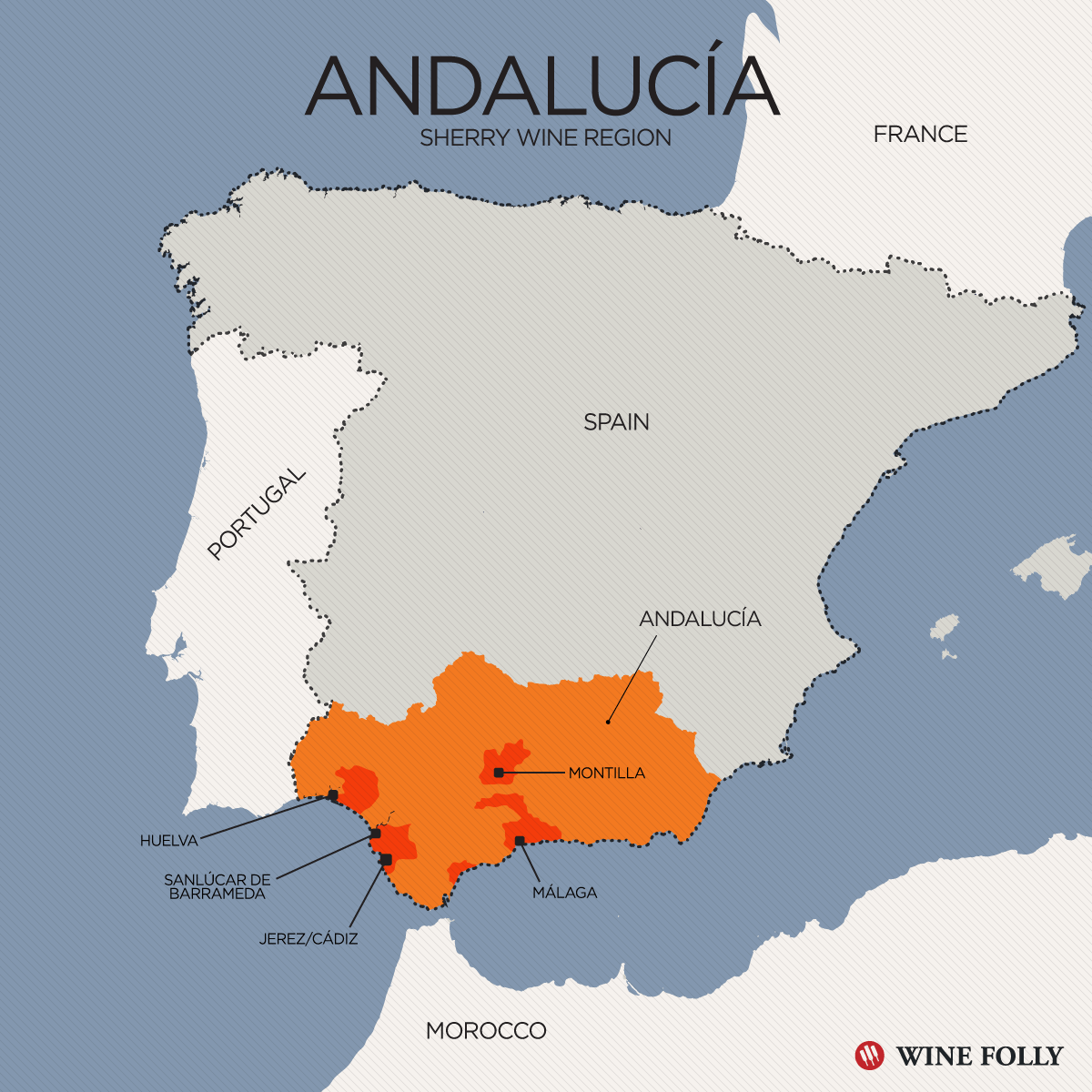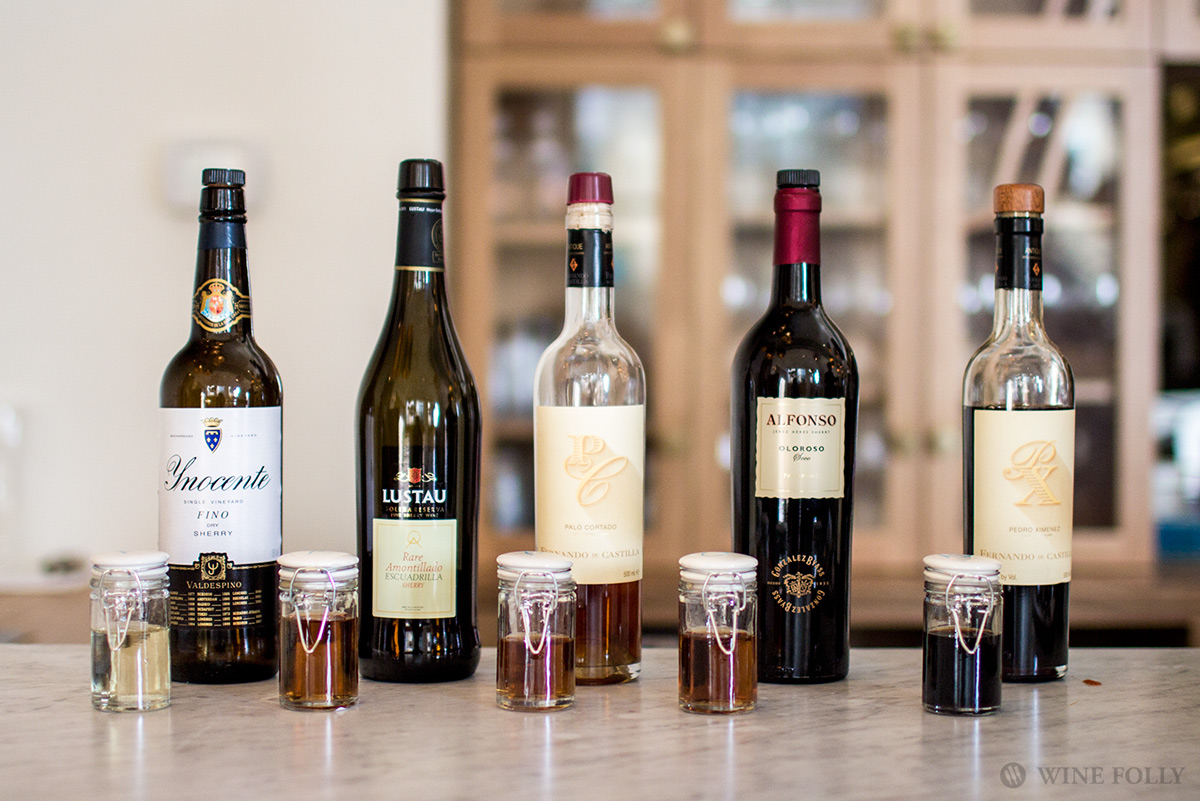Contrary to what some believe, Sherry wine isn’t sweet. In fact, most are dry. In Spain, Sherry wine is savored like a fine whiskey. Get to know the different styles of Sherry wine and which ones you ought to try (and even the ones to avoid).

A Guide to Sherry Wine
You have been lied to. Somewhere, somehow, you were taught that all Sherry is sweet, sticky, and unpalatable. Maybe it was a childhood sip snuck from a dusty old bottle kept atop grandma’s fridge or a cheap label of the mass-produced California “sherry” on the supermarket shelf.
If you’re a lover of brown spirits, then Sherry might be the favorite wine you’ve never tried.
What is Sherry Wine?
We can start with a few truths: Sherry is a fortified white wine from Andalucía in Southern Spain, and it has been made for centuries.
Most of it is dry and meant to pair with food. It’s also one of the greatest beverages on the planet.
Isn’t Sherry Just a Sweet Wine?
Some of the sweet styles make great dessert wines or fireside sippers (such as PX), but they aren’t representative of the whole.
Americans, with a thirst for sweet, soda-like beverages, gave this sweet Sherry a market in the mid-20th century, while the Spaniards and Brits kept the best, complex, and dry stuff for themselves.
In fact, the dry styles deserve their place alongside the world’s classic wines.

Where Does True Sherry Come From?
Sherry’s magnificence comes from the fact that, like Champagne, true Sherry can only be made in one tiny corner of the world. This area, known as the Sherry Triangle, includes the towns of Jerez de la Frontera, Sanlúcar de Barrameda, and El Puerto de Santa María. These locations are historically significant because they provide the unique winds, humidity, soil, and seasonal changes that give Sherry its singular character.
Many imitators have tried to replicate the salty, nutty, and aromatic profile of Sherry throughout history. Unlike litigation-happy Champagne, the Sherry Consejo Regulador and the Spanish government have not done much over the years to protect the Sherry name around the world, so many cheap imitations are still sold with the name Sherry on the bottle.
Most are sweetened bulk wines with chemicals added for color and flavor.
Isn’t Fortified Wine Too Strong?
Well, you’re supposed to drink less of it! Sherry’s powerful flavor and slightly higher alcohol content mean that a single serving can be about half of a normal six-ounce glass of wine. Sherry ranges from 15% ABV to over 20%.
Many full-bodied red wines like Argentine Malbec and Napa Valley Cabernet clock in at 15-16% alcohol or more, so you shouldn’t be too worried. This extra strength actually helps Sherry pair well with many foods.
Types of Sherry Wine
Now that we’ve explored the rich lore of Sherry, here are a few tips for buying Sherry and a few ways for pairing it with food.
Styles of Dry Sherry Wine
- FINO & MANZANILLA: These are the lightest styles of Sherry. These age, for as few as two or as many as ten years, under a layer of flor and when bottled are meant to be consumed right away. They are delicious with olives, Marcona almonds, and cured meats. With oysters, Fino and Manzanilla Sherry vie with Champagne as the greatest pairing on earth.
Try González-Byass’ classic Tío Pepe Fino for a light, crisp classic. For something more funky, try the single-vineyard Valdespino’s Fino Inocente or Hidalgo’s La Gitana Manzanilla En Rama, which is bottled straight from the cask without filtration. Serve Fino and Manzanilla cold for the best results.
- AMONTILLADO: When a Fino’s layer of flor fades or the wine is intentionally fortified to a high strength, it begins to oxidize and change character. This is an Amontillado Sherry or, simply put, an aged Fino. These wines have the same salty bite of a Fino, but with a darker color and a nuttier, richer finish on the palate. Amontillado Sherry is also a versatile food wine, sidling comfortably up to prawns, seafood soup, roast chicken, or a cheese plate.
Try Lustau’s Los Arcos for a rich, stylish classic, or Williams & Humbert’s Jalifa 30 year-old VORS for something intense and unforgettable.
- PALO CORTADO: This is a strange, beautiful and less common style of Sherry that occurs in certain circumstances when flor yeast dies unexpectedly and the wine begins to take on oxygen. A Palo Cortado has some salty character, but its body is richer and more intense. Palo Cortado can behave like an Amontillado on the palate but often shows a great balance of richness and delicacy.
Try Valdespino’s Palo Cortado Viejo for something delicious and complex, or Hidalgo’s Wellington 20-year for a showpiece.
- OLOROSO: Oloroso never develops flor. Instead, all the flavor in these wines comes from the interaction of wine and air. Usually oxidized wine is considered faulty, but when left for five to twenty-five years, the wine in a Sherry solera will develop into a full-bodied, dark, and expressive substance that begs to be enjoyed with braised beef, bitter chocolate, and blue cheese. Oloroso Sherry is aromatic and spicy, and can drink like a finely aged bourbon.
Try González Byass’ Alfonso for an archetypal Oloroso, or Fernando de Castilla’s Antique for something rareified and memorable.
There’s no other wine that offers the age and complexity of Sherry for the price.
Now that you have a good impression of the styles of Sherry wine, here are some additional things that, when combined, make Sherry unique among all the wines in the world.

The Fortified Wine in the Age of Exploration
When sailors roamed the oceans in the Golden Age of exploration, they always brought alcohol with them. Water was disease-ridden and unreliable, and wine or rum was added to water for its antiseptic properties.
Since casks of wine would spoil after weeks in the hot tropical sun, merchants added brandy to their barrels to “fortify” the wine and protect it. The British began to prefer their wine this way and their merchants set up shop in Jerez de la Frontera, where they began to fortify the local wines for shipping.
It helped that Sir Francis Drake had raided the port of Cádiz near Jerez in 1587 and seized a few thousand barrels of Sherry. Upon his return to England, Drake’s stolen wine became all the rage and gave the wines of Jerez a devoted market.

Jerez, A Place Apart
No place in the world that can make wines like those of Jerez.
It’s not just the white chalky soil and warm sun that make Jerez’s wines exceptional. The Poniente and Levante winds blow across the region and give the open-air cellars the right combination of humidity and temperature to gently age the wines in barrel.
A unique phenomenon called flor happens in Andalucía’s warm seaside climate. In barrels of new wine each year, a layer of yeast will form on the surface of the wine and transform its flavors. Flor gives the wine a tangy, salty character as it matures. And maturing is what Sherry is all about.

The Wine Blender’s Art
Like most Champagne and Scotch, Sherry is a blended product. Old barrels of wine in a Sherry bodega are refreshed with slightly younger wine each year, and then the oldest blended barrel is bottled.
This is called the Solera system, and it creates a wine that is the product of as few as three or as many as 100 vintages, and is well worth the price. A Solera is, put simply, a group of barrels used to age a single wine; and the wine in these barrels will develop more complexity each year as fresh wine is added.

Sherry and Spirits
Sherry is aged in oak casks, which have proven themselves over centuries to be the best vessel for aging both wine and spirits. Once the Sherry cellar is finished with a cask, it’s sold to a distiller of Scotch.
If you’re a lover of brown spirits, then Sherry might be your favorite wine you’ve never tried. Many Scotch Whiskeys and rums are finished in used Sherry casks, lending that layer of nutty, toffee-glazed complexity so prized in a great dram. Macallan, Glenmorangie and many of the other great Speyside distilleries form their styles around this practice.
Sherry — especially a dark, rich Oloroso or a tangy Amontillado — can be just as intense as an aged whiskey. Spirits with 10 to 20 years of age command a high price, but many Sherries can be found under $20. Many are from Soleras where the youngest barrel is 10 years old and the oldest may be 100!

